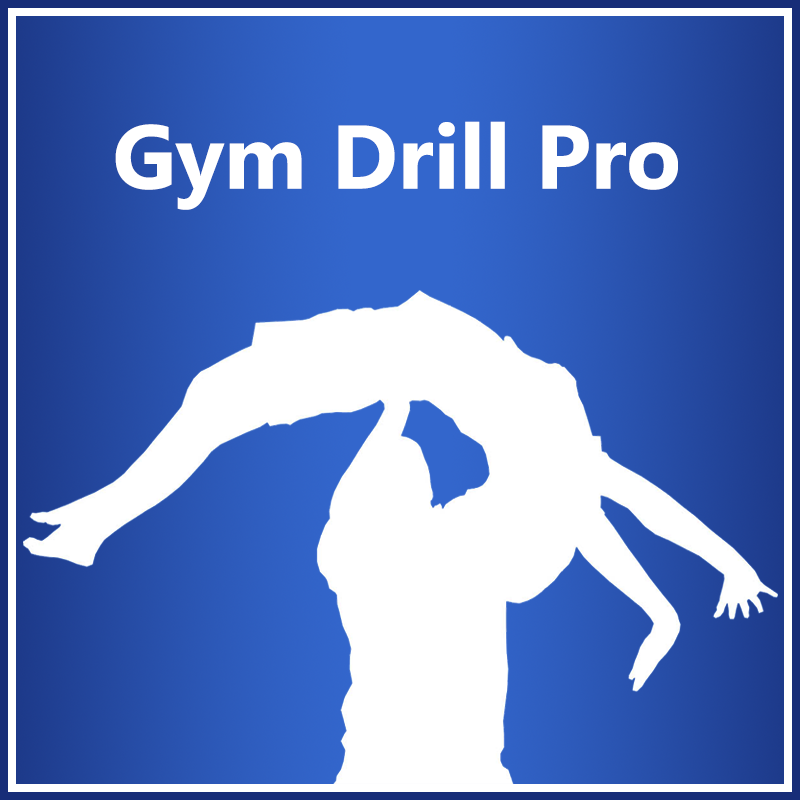

The vault is an artistic gymnastics apparatus on which gymnasts perform, as well as the skill performed using that apparatus. Vaulting is also the action of performing a vault. Both male and female gymnasts perform the vault. The English abbreviation for the event in gymnastics scoring is VT. To perform a vault, the gymnast runs down a runway (the run), which is usually padded or carpeted. They hurdle onto a springboard and spring onto the vault with their hands (the preflight or first flight, and block). For vaults in the Yurchenko family, the gymnast will put their hands onto a mat that is placed before the springboard, round-off onto the board and do a back handspring onto the vault. The off-flight may be as simple as leaping over the apparatus or as complicated as executing several twists and turns in the air. The gymnast then lands on the mat on the other side of the apparatus. (Wikipedia)
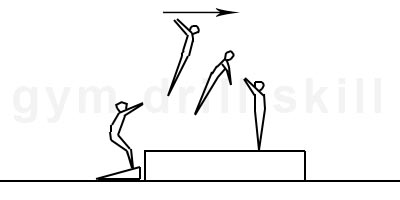
The gymnast should run and gradually increase their speed. They should perform a hurdle onto the springboard with their arms making a back-circle motion. The gymnast should rebound with their arms up, executing a slight stretch jump during the flight. They should land to a controlled position on the mat with their arms in front of their shoulders.
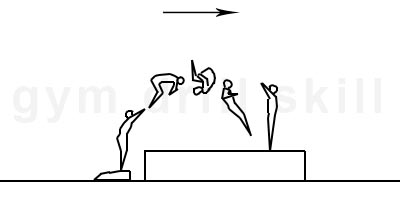
The last jump onto the springboard should be low and long. A strong push of the legs against the springboard, the body is extended. As the gymnast leaves the springboard arms should reach upward and forward as the centre of mass rises to shoulder height and the tucking rotation is started. Legs are bent, arms follow the legs. The body is extending prior to landing.
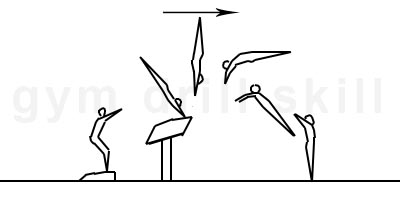
The gymnast should gradually accelerate as they get closer to the springboard. At the final step of the run, the gymnast should jump onto the springboard. This jump should remain low and long with their arms circling backwards. There should be a strong push from their legs against the board as their arms are swung forward into the take-off. During the flight onto the table, the gymnast’s heels should lift strongly and their arms should reach quickly to make contact with the table. The body should be slightly arched or straight, and should rotate around the hands. The block with the arms and shoulders must occur just before the handstand position. The gymnast’s head should be slightly backwards. The gymnast’s body should remain slightly arched during the flight phase, and the degree of rotation should be controlled by moving the arms upward or to the side. During the landing, the feet should land in front of the body. The gymnast’s legs, hips, and ankles should bend to control the landing.
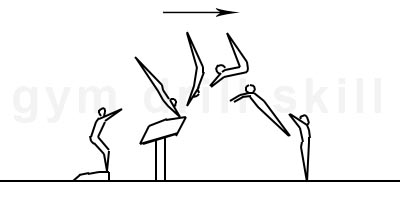
The first part of the Yamashita vault is very similar to a handspring. At the final step of the run, the gymnast should jump onto the springboard. This jump should remain low and long with their arms circling backwards. There should be a strong push from their legs against the board as their arms are swung forward into the take-off. During the flight onto the table, the gymnast’s heels should lift strongly and their arms should reach quickly to make contact with the table. The body should be slightly arched or straight, and should rotate around the hands. The block with the arms and shoulders must occur just before the handstand position. The gymnast’s head should be slightly backwards. As the body leaves the table during the vertical position, it should be fully extended. The gymnast’s feet should be held up, and their body should forcefully transition into a pike position as rapidly as possible. There should be a strong rotation of the upper body upward and forward toward the legs during this motion. The body should have a minimum of 135° in a piked position before forcefully re-extending into a fully stretched position by the time of landing.
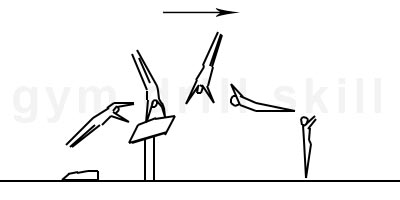
The roundoff on the table is a basic EG2 vault skill. Despite the similarities it has with the floor roundoff, the vault roundoff has some technical differences. The gymnast should run towards the table and gradually increase their speed. Their last step before reaching the springboard should be long and low. They should jump on the springboard with tight knees and their legs together. After the back circle during the hurdle, the hands should reach the table as fast as possible. Their first arm should reach the nearest end of the table, with this hand rotated one quarter to the side. The second hand should be placed further away, depending on the gymnast’s speed. This wide armed method is essential for creating a better block and higher take-off. The body should reach a half turn position in the handstand, with an energetic block and whip. At handstand, the body releases upward and opens prior to the landing. The gymnast should emphasize on the position of the hands on the table, the first one reaches the surface as fast as possible, evenly placed at the curve of the table (depends on the speed). The second one places as far as possible in order to block efficiently and to transform the speed into height for the second phase of the vault. The hand placement should occur before reaching handstand. The block and release should immediately begin during the handstand, not afterward.
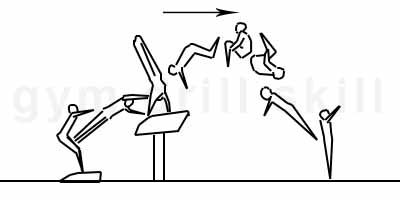
The gymnast should run towards the table and gradually increase their speed. Their last step before reaching the springboard should be long and low. They should jump on the springboard with tight knees and their legs together. Their hands should reach the table as fast as possible. Their first arm should be bent, with this hand rotated one quarter to the side. The second hand should be placed further away, depending on the gymnast’s speed. This wide armed method is essential for creating a better block and higher take-off. The body should reach a half turn position in the handstand, with an energetic block and whip. After the round-off, a back salto should follow before the gymnast’s landing. The knees should be bent in order to absorb the force from landing.
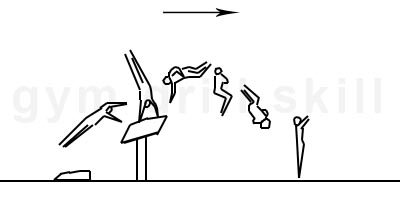
The Kasamatsu vault is similar to the Tsukahara full twist. In the Kasamatsu vault, the body starts turning away from the horse from the quarter turned position in the pre-flight. For example, if the gymnast has done a left quarter turn to get onto the horse, the last push should happen from the right hand. Then, the body should turn to the left (away from the horse). This is the same direction as the first quarter turn in the pre-flight. The blocking action from the right shoulder should finish with the body facing forward. The first half turn action should already be completed at this point. If the gymnast does a front somersault and a half turn from here, the body will have completed a full twist. The gymnast should land facing the horse.
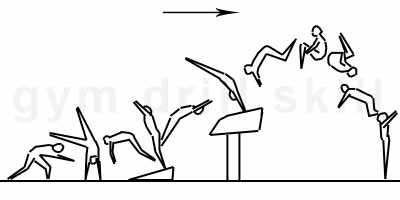
The vault starts with a roundoff. The gymnast should execute a standard hurdle, raising their arms up and opening their shoulder angle. They should perform a strong kick from the back leg, and then push off the floor with their lunge leg. A the last moment, the gymnast should place their first hand sideways on the floor. In the handstand position the legs should already be together. At this point the gymnast should turn another ¼ and place their second hand on the floor. If performed properly, the gymnast should finish the half turn slightly before handstand in an extended, tight position. Next follows an effective snapdown with a push from the hands. The round off should finish in a hollow body position with the legs tight. The head should be slightly down with the arms at horizontal so they can be ready for a strong kick back. The next move is the back handspring. The gymnast’s body should transform into a tight arch. There must be a strong arm kick backwards. The gymnast’s head should be slightly open and follow the hands. The gymnast should reach the table slightly before handstand in an arched position. There are two methods for the blocking action. The first is a regular block, similar to how it would be performed on the floor - snapdown block. In this case the gymnast’s arms should push the surface downward. After that, the upper body should transform into a hollow. The second method is pushing opposite (upward). This technique is more convenient for high difficulty skills such as Yurchenko layout, with twists, etc. It helps the gymnast obtain a higher take-off. It’s suitable also for more experienced gymnasts who have developed a faster run. After the snapdown the gymnast should perform a back tuck before landing on the floor.
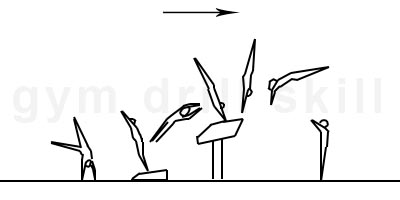
This vault starts with a roundoff. The gymnast should execute a standard hurdle with them raising their arms up and opening their shoulder angle. There must be a strong kick from the back leg, and an effective snapdown by pushing on the floor. The roundoff should finish in a hollow body position, with tight legs. The gymnast’s head should be slightly down with their arms at horizontal. This will allow them to be ready for a strong kick back. The next move is the back handspring with a half turn during the first phase of the skill. The gymnast should perform the half turn before reaching handstand on the table. The gymnast should turn from their hip, and at the same time they should execute a strong back kick from their arms. They should block the table while they’re in handstand (no later than this). Next follows a regular front handspring. The difference between the Yurchenko vault and this vault is the half turn. Emphasize on the half turn from the hip (center of gravity), and a strong kick from the heels.
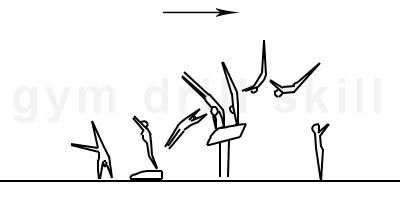
This vault starts with a roundoff. The gymnast should execute a standard hurdle with them raising their arms up and opening their shoulder angle. There must be a strong kick from the back leg, and an effective snapdown by pushing on the floor. The roundoff should finish in a hollow body position, with tight legs. The gymnast’s head should be slightly down with their arms at horizontal. This will allow them to be ready for a strong kick back. The next move is the back handspring with a ¾ turn during the first phase of the skill. The gymnast should perform the ¾ turn at handstand on the table or slightly before. There are two types of blocking actions. One is a regular block as the gymnast is performing it on the floor - snapdown block. In this case, the arms push the surface downward and after that upper body transforms into a hollow. The second type is pushing in the opposite - upward. This technique is more convenient for high difficulty skills with twists. It helps the gymnast to obtain a higher take-off. It’s also suitable for more experienced gymnasts, who have developed a faster run. In the handstand, the body releases upward and opens prior to the landing.
Integral part of gymnastics coaching process are skill drills. They help gymnasts to learn easier and technically correct. With GYM DRILL PRO you will find variety of ideas for the most the basic gymnastics skills. There are plenty of images with skill drill progressions. It is intended to support explicitly the qualified coaches in their daily coaching business. DO NOT practice without the guidance of proper professionals.